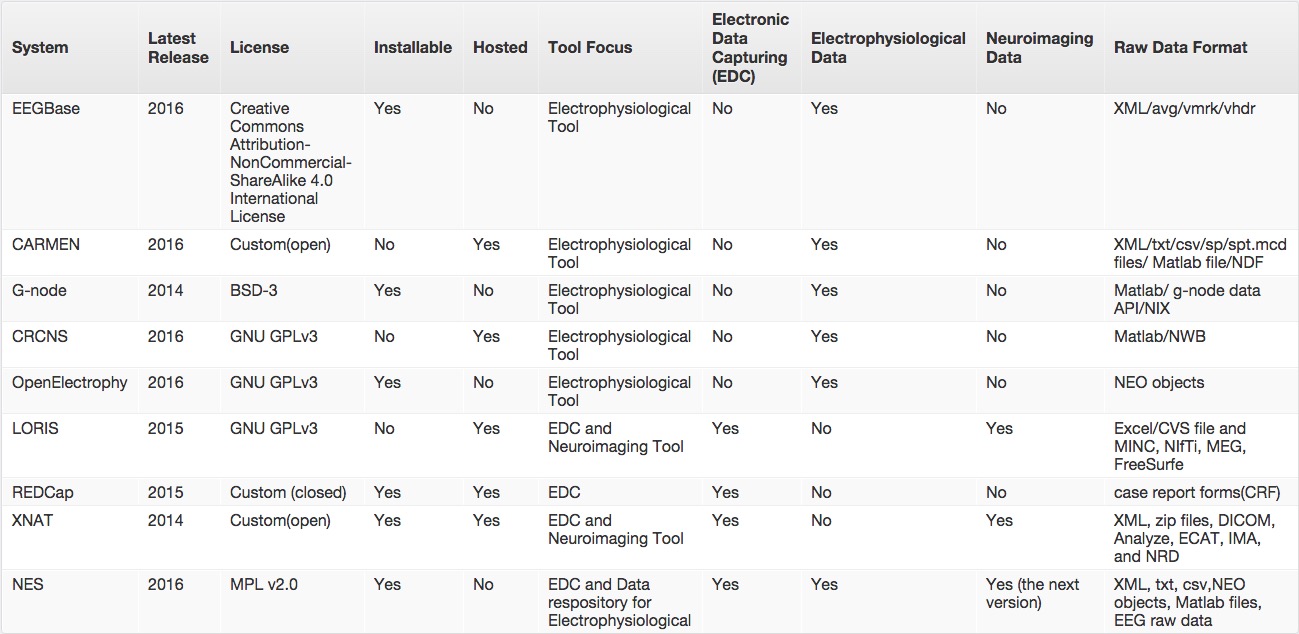
New functionalities to store neuroscience data and metadata in NeuroMat’s freely-shared computational tool
Aug 01, 2016
The Neuroscience Experiments System (NES) is an open-source tool to assist in the organizational control and management of clinical and experimental neurophysiological data gathered in use in laboratories, that the technology-transfer team at FAPESP’s NeuroMat has developed since 2014. A scientific challenge that the development of this tool addresses is that neuroscience experiments generate heterogeneous data formats and complex metadata, such as provenance information, and NES —currently available on a 0.12 version — intends to provide a unified repository for data and metadata from different natures (i.e., clinical, imaging, behavioral). Furthermore, NES can manage electrophysiological data from EEG and EMG as well as performing the integration of this data with electronic questionnaires filled by each participant in the context of an experimental protocol.
The building of NeuroMat’s unified repository has at least two relevant distinctive features. Firstly, NES allows the linkage of the electronic record at each step of the experimental protocol. This feature is associated to the goal of assisting researchers in their data collecting routine throughout a neuroscience experiment, thus providing general and detailed accounts of the experimental protocol. This supports the verification and reproduction of results obtained in experimental investigations. Secondly, NES imposes a common format for representation and storage of data produced in a same laboratory or research group, so the stored data has better quality and is easier to be anonymized, publicly shared and reused. This feature improves the capacity of querying and analyzing data.
The neuroscience community has normally agreed that a uniformed view of experimental data is essential to effectively progress in the understanding of the brain; yet, this is still not fully supported by the neuroscience databases publicly available today. A reference in the literature is Koslow’s "Should the neuroscience community make a paradigm shift to sharing primary data?”, in Nature Neuroscience, 2000. NeuroMat’s technology-transfer team has been actively in contact with the International Neuroinformatics Coordinating Facility (INCF) and has formalized a collaboration. INCF members came to NeuroMat’s High-Performance Computing, Stochastic Modeling and Databases in Neuroscience, in April 2016. This collaboration has initially included the participation in task forces, such as the ones on electrophysiology and on neuroimaging, and could lead to having a central role in the INCF Program on Standards for Data Sharing.
The development of NeuroMat’s computational tool has been done in a context of intense reviewing of guidelines and models most widely used by neuroscientists in the representation and storage of experimental data. A key aspect in this review is how guidelines and models have dealt with provenance information, "metadata which is used to record the experimental protocol (a specific preparation for realization of the experiment by scientists), the purpose of the experiment and details about its data results, as well as formal annotations and notes made by scientists,” according to a recent publication by NeuroMat’s technology-transfer team.
According to an abstract that is to be presented at Neuroinformatics 2016, the annual INCF congress, "NES was developed to keep together experimental data and its fundamental provenance information, defined by the seven W's (Who, What, Where, Why, When, Which, (W) how). Examples of provenance information maintained by NES are: information about the scientists responsible for the experiment and collection of data and the description of the subject groups (who); the details about the recording protocol or behavioral data collection (e.g. the types of data collection performed) (what); the details of the experimental protocol used in the collection of primary data (how); the start/end date-time for data collection (when); the purpose of the experiment (why); the information about the experimental conditions to which the groups of subjects are submitted, such as tasks to perform and stimulus to apply (which); the information about the laboratory where data was collected (where) and even publications or other results that have arisen from the study of the collected data. Scientists can also record additional details for each experiment’s volunteer, such as the information about his/her clinical history and sociodemographic data”.
In the process of its development, NeuroMat’s NES has been compared to the most widely adopted tools to manage data from neuroscience experiments. The table below summarizes this comparative effort, taking into account license, installation and hosting procedure, tool focus, electronic data capturing, electrophysiological and neuroimaging data collection, and raw data format.
 |
The use of NES has been made accessible by the release of step-by-step description and online tutorials. A documentation for this computational tool is available on GitHub. The participation at INCF’s annual congress in September is an opportunity to inform the international community of the newest features of NeuroMat’s computational tool.
This piece is part of NeuroMat's Newsletter #30. Read more here
Share on Twitter Share on Facebook| NeuroCineMat |
|---|
|
Featuring this week: |
| Newsletter |
|---|
|
Stay informed on our latest news! |
| Follow Us on Facebook |
|---|




